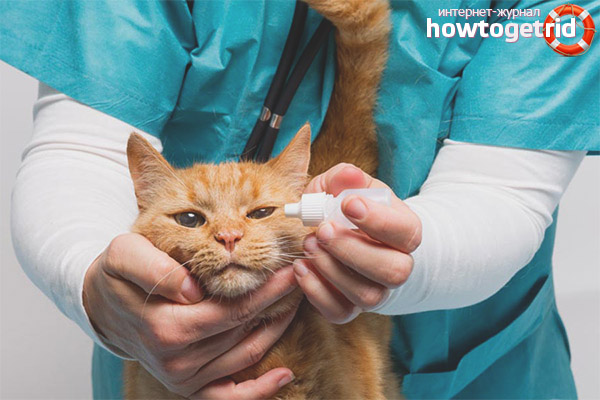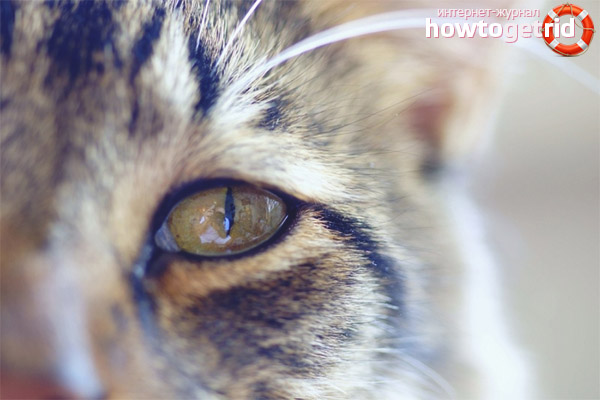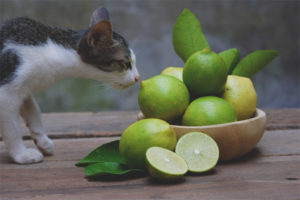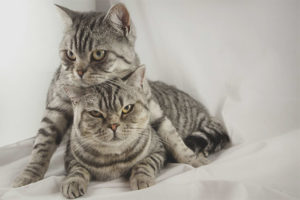The content of the article
Inflammation of the conjunctival membrane of the eye is called conjunctivitis. Ailment is more common as a concomitant symptom of a disease. The independent form of the given disease is less often diagnosed. Cats, like many other animals, can have conjunctivitis. The development of the disease lead to various negative factors.
Causes of the inflammatory process
The inflammatory process in the eyeballs can develop due to:
- injury;
- foreign body penetration;
- irritations with acids and gases;
- dust irritation;
- penetration of pathogenic agents;
- infection development;
- parasites.
Before starting treatment, it is necessary to identify the nature of conjunctivitis. Only after elimination of the direct cause of the disease will the stage of recovery begin with proper quality treatment.Therapy should be aimed at the elimination of the infectious-inflammatory process, the restoration of the cellular structures of the eye membrane and the prevention of complications.
Typically, an infectious-inflammatory process is caused by fungal infections, streptococci, staphylococci, gonococci. The disease can be infectious and non-infectious. Laboratory analysis of secretion from the inflamed eye will help determine the type of pathogen. Non-infectious type of disease causes dust, allergies, exposure to chemicals and gases.
Types of conjunctivitis
There are several varieties of the disease. In cats, conjunctivitis can be:
- acute catarrhal;
- purulent;
- chronic;
- follicular;
- parenchymal.
In the acute form, the lining of the eye swells and moderate tearing occurs. The medium of discharge from the eye is transparent, but every day it becomes more turbid and thick. Secretions accumulate in the form of lumps in the corners of the eyes, mucous filaments can be observed at the inner corners of the eyes. Sometimes the skin of the animal is irritated by the discharge, which causes the fur to fall out in places of irritation.Discharges can dry out after sleeping cats and turn into a dry crust, gluing the eye. If the animal is not treated, the disease enters a chronic stage.
Purulent form is characterized by lesions of both eyes. Observed:
- general depression of the cat;
- poor appetite;
- discharge of pus from the swollen area;
- swelling of the eye;
- the performance of the red mucous membrane behind the contours of the orbit;
- increased t;
- sore eyes.
Follicular form of the disease is considered the most severe in veterinary practice. On the surface of the eyelids, the follicles become inflamed, red small rounds appear. At the same time, the eye becomes narrower, blepharospasm, reaction to light, and lacrimation are diagnosed. A turbid film appears on the conjunctiva.
Parenchymal conjunctivitis is manifested by swelling of the eyelids and damage not only to the eye shell, but also to other areas. When you touch the eyes, there is severe pain. A prolonged illness can lead to blindness of the animal.
The diagnosis of the disease and its form is established by the veterinarian after the examination. For the appointment of the correct antibiotic therapy is required to establish the type of pathogen that caused inflammation. To do this, send the secret secreted from the eyes to the veterinary laboratory.
Main symptoms
The cornea is often involved in the inflammatory process. An animal may lose its sight if it does not start timely treatment. The disease is usually manifested by hyperemia and swelling of the conjunctiva. Red bubbles may appear on the eyelids. The animal sleeps a lot, does not play. Perhaps lack of appetite and activity. The depressed state of your pet indicates the onset of the disease. The cat narrows its eyes, tears are trickling from their shells. Every day the secret secreted from the eyes becomes thicker and duller.
In some cases, body temperature may increase. In a normal healthy state, the body of an animal is 38-39 degrees C. The kittens have a little higher. First aid to the animal should be provided at the first signs of a conjunctival lesion.
Treatment
Conjunctivitis is a rather serious problem that needs to be addressed with particular attention. You can not delay the start of treatment. The disease quickly becomes chronic, and complications will not keep you waiting.
Disturbance of various eye functions may develop, visual acuity will decrease. Intensive medical assistance to the cat will help to avoid the negative effects of the disease.
Prescribe medication for conjunctivitis should only the attending physician. The drug is chosen by the doctor depending on the type of pathogen. It is necessary to treat two eyes at the same time. Otherwise, the infection will quickly spread to the second.
There are basic rules of therapy:
- In any form of conjunctivitis, the mucous membranes of the eyes must be washed with antiseptic solutions. For this purpose, a weak solution of potassium permanganate or furatsilin is used. Antiseptic solutions are highly effective in eliminating infection and inflammation. Their constituent medicinal components detrimental effect on pathogenic microflora. Antiseptics contribute to the rapid healing of the mucous membrane, enhance local immunity,regeneration of affected cells.
- At the beginning of the development of the disease it is advisable to use a powerful antibiotic. When conjunctivitis prescribed drugs such as Sofradex, Tetracycline ointment, Levomycetin. Sofradex is a new generation drug that can be successfully used in the treatment of animals. The drug includes framycetin sulfate and dexamethasone. These two main components contribute to the cessation of the vital activity of pathogenic bacteria that cause changes in the envelope of the eyes. Sofradex comes in the form of drops. It is necessary to bury them in 1-2 drops in each eye 2-3 times a day. Pre-cleansing the affected areas of pus and mucus.
- Puffiness of the eyeball is removed by instillation of a solution of 1 ml of novocaine and 0.2 ml of hydrocortisone. If necessary, the veterinarian may prescribe another medicine.
It is important to prevent the acute form of the disease from becoming chronic. With a constant inflammatory process under the eyelids, it is necessary to gently apply antibiotic ointments and instil solutions with silver ions. Today, the pharmaceutical industry offers a wide variety of emulsions and ointments based on antibiotics.
Erythromycin or tetracycline ointment is widely used in treatment. Gentamicin ointment may also be used. Wash your eyes with an antiseptic before applying the drug. Next, a small amount of medicinal ointment is applied to a cotton swab. The eyelid of the animal lift and lay ointment under it. Speaking surplus ointment swab.
Treatment with follicular and purulent forms is carried out with antibiotic injections. Thrice daily, eye wash with boric acid solution is prescribed. This drug effectively kills pathogenic flora and promotes the rapid regeneration of mucosal tissues. After washing, an ointment with the prescribed antibiotic is placed under the eyelid. In some cases, the use of gentamicin helps to cope with the disease. Eyes instilled with solutions of this drug or drops with the inclusion of gentamicin in the composition.
With a sore eye veterinarian, it is advisable to perform a Novocain blockade. This helps reduce puffiness and relieve pain.
The inflammatory process is required to clean up very quickly. Otherwise, it can move to other structures of the eye. Then a longer treatment is required.With insufficient therapy, animal blindness is possible.
Complications of conjunctivitis
Unfortunately, even the most competent treatment of the disease can lead to complications. This may be due to autoimmune reactions in the body of the animal, reduced immunity, penetration of the virus into the body.
To the development of complications lead:
- delayed initiation of therapy;
- self-treatment without veterinarian control;
- the addition of a bacterial infection;
- virus attachment;
- reduced immunity;
- treatment with an improper antibiotic.
The use of antimicrobial drugs helps prevent the development of complications. However, in some situations there may be:
- fusion of the cornea and iris;
- ulcers;
- reduced visual acuity;
- the spread of infection;
- damage to other organs;
- blindness.
Very often the inflammatory process causes the appearance of sores on the eye and around it. Relapse occurs when ailment is neglected. Ulcers are very difficult to treat. In this case, the therapy should be prescribed only by a veterinarian who assesses the condition of the optic organ.
Corneal inflammation or keratitis is the most common complication. Corneal tissue is no longer shiny and transparent. The eye becomes cloudy. A positive result in the treatment can give antimicrobial agents prescribed by a veterinarian. Also prescribed eye drops with an antibiotic. In the presence of the virus, special medicinal sera are used. The course of treatment of keratitis is quite long. You must always follow all medical prescriptions.
Prevention
If a cat visits the street, it is necessary to examine its eyes daily. In case of dust, the eyes should be washed with a solution of potassium permanganate or furatsillina. When tearing is required to eliminate the negative effects of substances that caused it.
It is necessary to vaccinate an animal against various viruses and infections in a timely manner. This strengthens the cat's immunity and prevents the infectious process from developing in the body. After the habit, the risk of developing the disease is reduced several times.
Favorite is required to regularly comb. Removal of dead hair and skin particles from the cat’s body prevents skin damage near the eyes and subsequent infection with dangerous microorganisms.Get a special comb for the cat and daily brush it from dust and dirt.
It is necessary to follow the diet. A well-fed healthy animal rarely picks up the infection and gets sick. Immunity should be strengthened with vitamins. It is important to timely de-worming your pet.
Video: how to treat conjunctivitis in cats and cats













To send